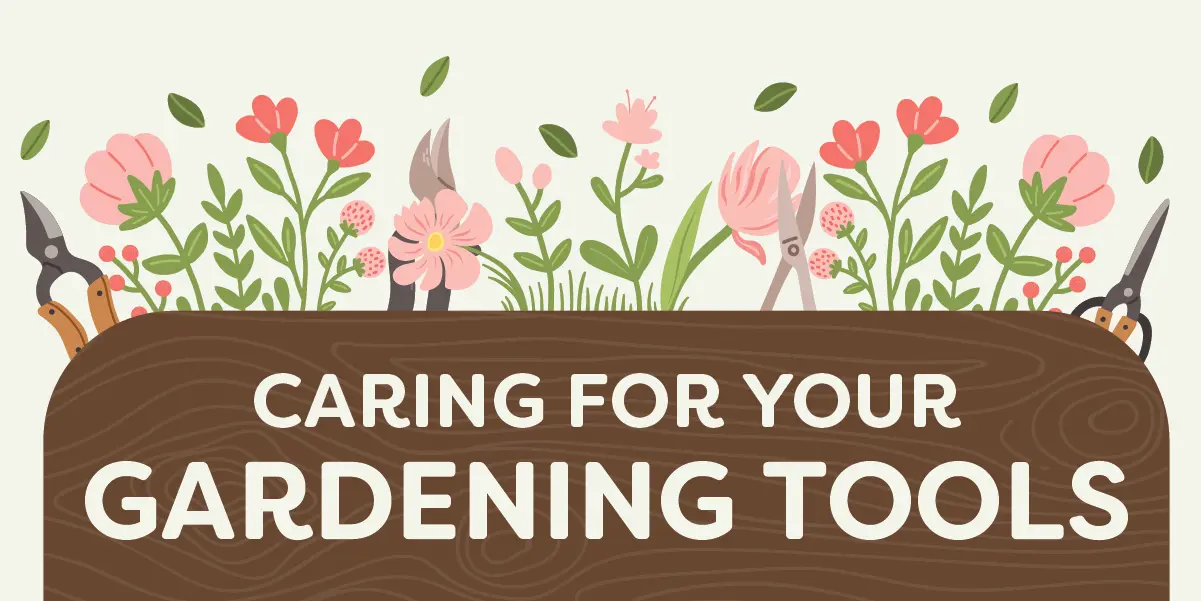A clean shovel is a thing of beauty.
Not hardware store clean, but fresh from the garden and properly cleaned for storage. Just as your prize-winning tomatoes need care, so do the tools that help you cultivate them.
Why Proper Tool Care Matters
Sharp, clean, and well-maintained garden tools are safer and work more efficiently.
- Dull pruners require more force to cut and leave ragged edges on your plants. A clean shovel glides through the soil compared to one caked with mud.
- Dull or damaged tools can tear and crush delicate plant stems. Clean tools are less likely to carry diseases from plant to plant. Taking care of your tools translates into a healthier garden.
- Well-maintained tools resist rust, corrosion, and wear and tear. This means they’ll last longer, saving aggravation and money.
Cleaning & Drying Your Garden Tools
Always clean your tools after a gardening session.
- Rinse tools with a hose to remove larger soil particles.
- Use a stiff brush or putty knife to scrub away the remaining dirt. For stubborn grime, apply a mixture of water and mild soap.
- Use mineral spirits on a cloth to wipe off sap or resin.
- Rinse tools with water after scrubbing.
- Dry tools thoroughly with a clean cloth to prevent rust. Place them in the sun for a few hours until bone dry for added protection.
- Lubricate moving parts with oil to inhibit rust and ensure smooth operation.
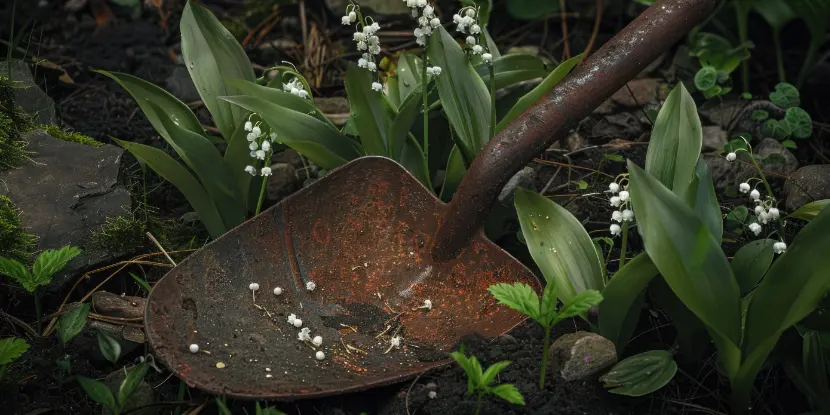
Rust can be sanded, brushed off, or removed with the help of vinegar.
Sharpening Blades & Edges
Some garden tools need regular sharpening to be effective. These include:
- Pruners and shears
- Shovels and spades
- Hoes
- Lawn mower blades
- Edging tools
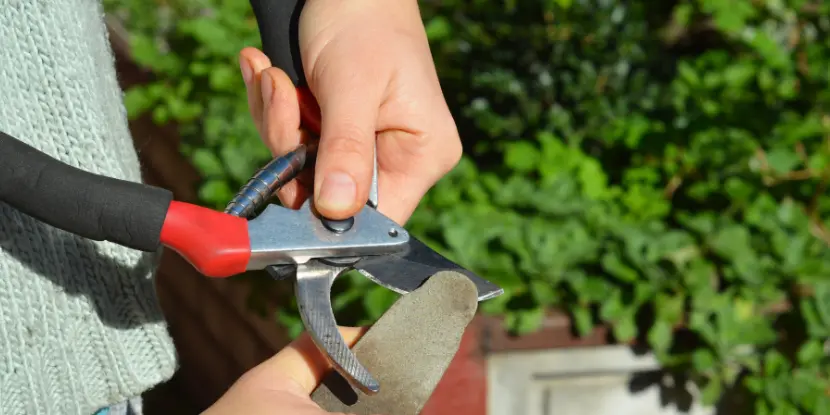
Sharpening garden shears with a whetstone.
How to Sharpen Garden Tools
- Clean the tool: The tool should be free of dirt or rust.
- Inspect the blade: Check for any nicks, damage, or wear. This will help you understand how much sharpening is needed.
- Secure the tool: Use a vise or clamps to hold the tool in place while sharpening. Safety first!
- Choose the right file: A flat metal file works well for most straight-edged tools, while a round file is best for curved blades.
- File at the correct angle: When filing, maintain the original angle of the edge. For most tools, this is a 20-to-30-degree angle. File in one direction — toward the edge of the blade.
- Finish with a sharpening stone: For a finer edge, apply a few drops of oil or water and gently run the blade across a water stone or oil stone.
- Remove burrs: A burr may form on the opposite side of the edge you’re sharpening. These are thin ridges of metal that dull the blade. Remove them by lightly running your file or stone along the flat side of the blade.
- Clean and oil: Wipe off any metal filings. Lightly coat the blade with oil to protect it from rust and corrosion.
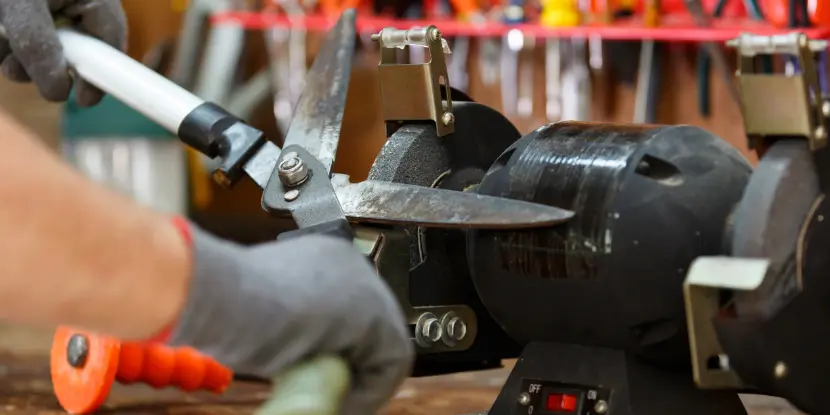
A power grinder can sharpen larger blades but requires skill to operate.
Lubricating Garden Tools
Pruners, shears, loppers, and any other tools with hinges or gears should be lubricated often to prevent rust and keep moving parts moving.
- Apply a light coat of oil to the hinges and moving parts with a cloth or brush.
- Wipe off excess oil to prevent dirt and gunk buildup.
- If using a spray lubricant, cover surrounding surfaces to avoid overspray.
- For tools frequently exposed to moisture, use a dry lubricant like graphite powder instead of oil.
Maintaining Wooden Handles
Quality wooden handles can last for many years with proper care. Follow these steps to guarantee their longevity:
- Clean the wood: After every use, wipe down the handle with a damp cloth to remove dirt and sap. Use a mild soap solution for tougher grime, rinse thoroughly, and dry.
- Sand down splinters and rough spots: Regularly inspect the handle for rough areas. Smooth these out with fine-grit sandpaper to maintain the integrity of the wood and prevent injuries.
- Check for cracks: Periodically inspect the handle for cracks or damage. Repair small cracks with wood glue. Clamp the cracked area until the glue dries completely.
- Seal and protect the wood: Apply a protective oil or sealant to the handle to prevent moisture damage. Linseed oil is a top choice for its natural protective properties. Allow it to soak in and wipe away excess oil.
- Tighten loose handles: Tighten any screws or bolts. If the handle is wedged into the tool head, remove it, apply wood glue, and reinsert. Allow the glue to dry completely before use.
- Store properly: Keep tools with wooden handles in a dry, cool place to prevent swelling and warping from moisture.
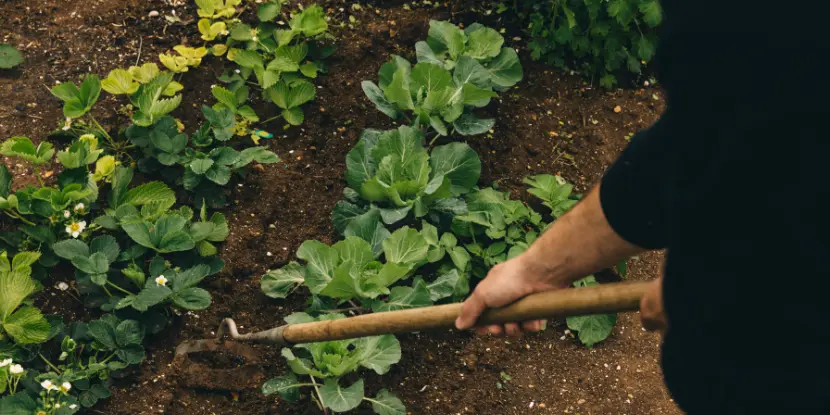
Hoes, shovels, and other gardening tools should be cleaned after every gardening session.
Replacing Worn or Broken Parts
Which Damaged Parts Can Be Replaced?
- Pruner blades
- Shovel and rake handles
- Springs and bolts in shears and loppers
- Wheels on garden carts
- Lawnmower blades
- Saw blades
Where to Find Replacement Parts
- Check with your tool’s manufacturer: Many manufacturers offer replacement parts for their products.
- Visit a local hardware store or garden center: They may have universal parts that fit different tools.
- Search online: You may find the exact part you need through an online retailer.
When Is It Better to Buy a New Tool?
- When the cost of replacing a part is equal to or greater than buying a new tool.
- If multiple parts need replacement.
- If the tool shows signs of wear and tear.
- If replacement parts are hard to find or discontinued.
- If a new tool offers improved features and functionality.
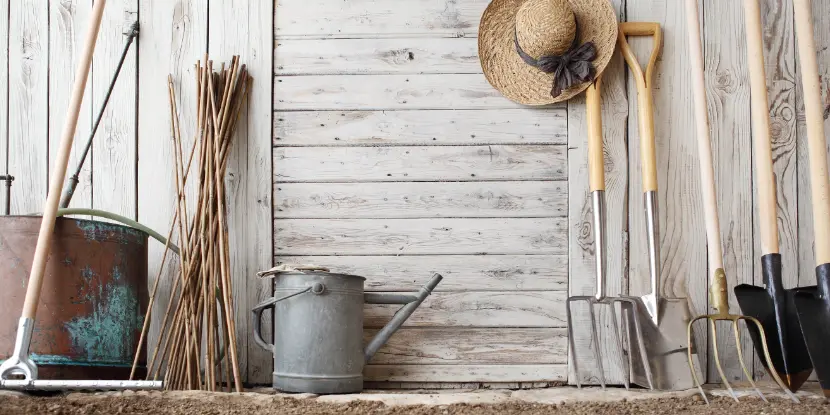
Clean garden tools ready for storage.
Storage: Keeping Your Tools Safe
Proper tool storage is just as important as cleaning and maintenance.
- Store tools in a cool, dry place to prevent rust and corrosion.
- Hang tools with sharp edges or blades on hooks or racks to avoid damage.
- Use a tool caddy or organizer to keep smaller tools in one place.
- Clean and dry tools before storing them to avoid moisture damage.
- Keep larger, heavy tools off the ground to prevent warping or bending.
- Invest in a high-quality shed or storage cabinet for long-term protection.
FAQs: How to Care for Garden Tools
Q: Can I use vegetable oil to lubricate my garden tools?
Yes, although it’s less durable than mineral oil. Vegetable oil is an eco-friendly option that won’t harm plants. However, you’ll need to reapply it more often than with traditional lubricants.
Q: How often should I sharpen my garden tools?
That depends on the frequency of use and the types of materials you’re cutting. A good rule of thumb is to sharpen your cutting tools at least once at the beginning of the gardening season. Heavy users may need to sharpen tools more often, such as every 4-6 weeks during peak gardening.
Q: What should I do if my tools start to rust?
Remove rust with a wire brush or sandpaper. Apply a coat of protective oil or silicone spray to prevent further rusting. For severe rust, soak the tool in vinegar overnight before scrubbing.
Q: Is it necessary to disinfect my garden tools?
Yes, especially if you’ve used them on diseased plants. Disinfecting prevents the spread of disease to healthy plants. Use a solution of one part bleach to nine parts water or a commercial disinfectant designed for gardening tools.
Q: Can I sharpen garden tools with a power grinder?
Yes, but a power grinder can easily damage your tools. A hand file or sharpening stone offers more control and is less likely to damage the blade.
Q: What’s the best way to store a garden hose?
Drain it after use, and store it out of direct sunlight in a cool, dry place. A hose reel or hose hanger helps prevent kinks and cracks.
Q: Are there any special considerations for battery-powered garden tools?
Battery-powered tools should be stored in a dry location away from extreme temperatures. Always follow the manufacturer’s instructions for charging and storing batteries.
Q: How can I maintain the battery life of my cordless garden tools?
Avoid leaving batteries drained for extended periods. Store batteries with a partial charge in a cool, dry place. Also, avoid overcharging by unplugging the charger once the battery is fully charged.
Q: What’s the best way to clean sap and resin from pruning shears?
Rubbing alcohol and sap remover products will clean sap and resin from pruning shears. Apply the alcohol or remover, let it sit for a few minutes, then wipe clean with a soft cloth. Lubricate the shears after cleaning to prevent rust.
Q: Can garden tools be recycled?
Yes, many garden tools, especially metal ones, can be recycled. Check with your local recycling center for guidelines. Broken wooden handles can be composted if untreated, while metal parts may need to go to a scrap metal facility.

